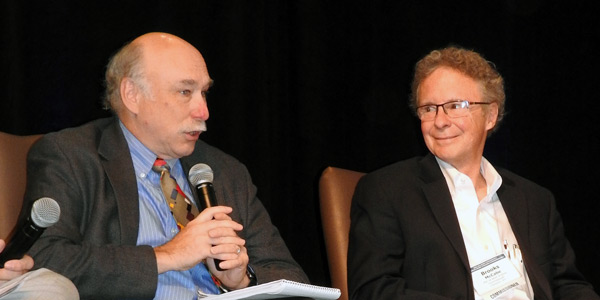By Rory D. Sweeney
HERSHEY, Pa. — Near the end of the final panel at last week’s Mid-Atlantic Conference of Regulatory Utilities Commissioners conference, PJM’s Stu Bresler was asked what it would take for the RTO to take the lead on developing a large-scale, regional transmission line from Virginia to New York City to help take advantage of offshore wind capabilities in the Atlantic Ocean.
“My knee-jerk, flippant answer is a whole lot of money,” said Bresler, PJM’s senior vice president of markets and operations. “It’s difficult at this point to build a reliability case for that kind of infrastructure investment. I think what’s required is more a business case for the generation to say that level of investment is rational.”
PJM would know. Every month, a heated debate flares up at its Transmission Expansion Advisory Committee meetings to examine the details, costs and necessity of proposed transmission projects. American Municipal Power’s Ed Tatum often leads the discussion.
As a member of a panel on transmission replacement earlier at the conference, Tatum revealed that when he was brought on at AMP, he was given a mission to reduce its members’ transmission costs. He responded that controlling their costs would be a more reasonable goal.
That could be because much of the transmission grid needs replacement, and transmission owners are often sensitive to any implication they’re overbuilding the system. Tatum’s fellow panel participant, Jodi Moskowitz of Public Service Electric and Gas, took exception to that suggestion in her opening remarks.
“We don’t look at the issue quite that way, in terms of if the transmission system is overbuilt,” Moskowitz said. “We think that the appropriate focus is to make sure that we have a safe, reliable grid for many years to come, but make sure we are planning and building in a cost-effective way.”
And even that might be more expensive than customers want to pay. Speaking on the fuel mix panel with Bresler, Rich Sedano of the Regulatory Assistance Project said the one-day-in-10-years loss-of-load expectation that PJM and other grid operators use is a handy standard, but not necessarily indicative of what the market will bear.
“If you ask people how much they’re willing to pay to keep the lights on, it’s a lot less than the imputed one-day-in-10-years standard,” he said.
That clash over cost versus demand would be cleared up through increased competition and cost-containment measures in transmission construction, LS Power’s Sharon Segner said. “If you read the [court] orders on why competition was upheld, it’s because of the argument for the consumer benefits of competition.”
While Segner said that cost containment offers price assurance, Moskowitz cautioned that there will always be “uncontrollable issues” that occur during construction.
Expressing the states’ perspective, West Virginia Public Service Commissioner Brooks McCabe called for restraint on all sides. During the transmission panel, he urged slowing down the decisions to construct large-scale projects and to revisit the “fundamental ground rules” to “tweak” when and how projects should be addressed.
On the fuel mix panel, he urged everyone to “lighten up” because the “hard work” would not be solved immediately. Retaining baseload units is important, he said, because “that’s our security blanket.”
Matt Crozat of the Nuclear Energy Institute had a mixed reaction to that message. He said he can’t be relaxed like McCabe because “I know that if I lose nuclear plants, I can’t get them back.”








